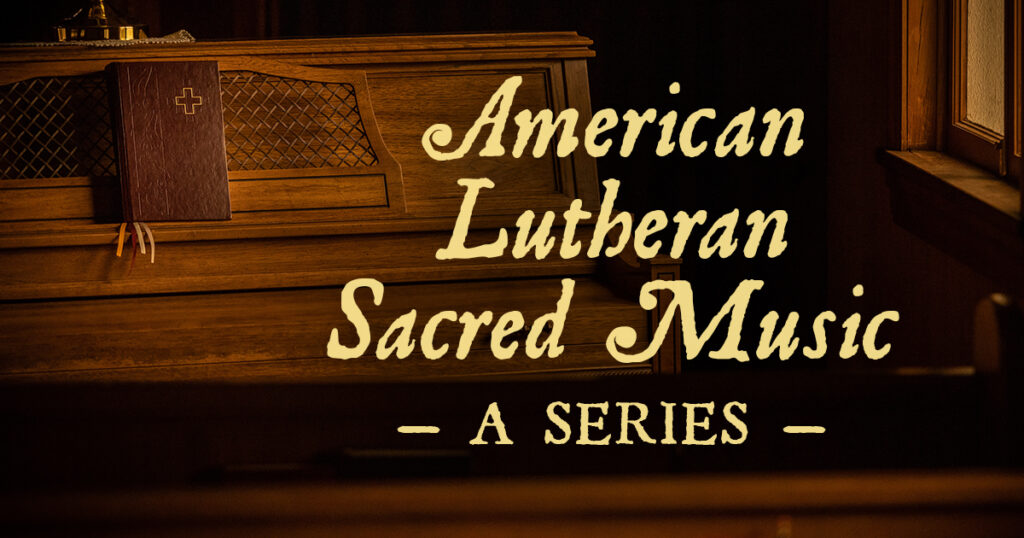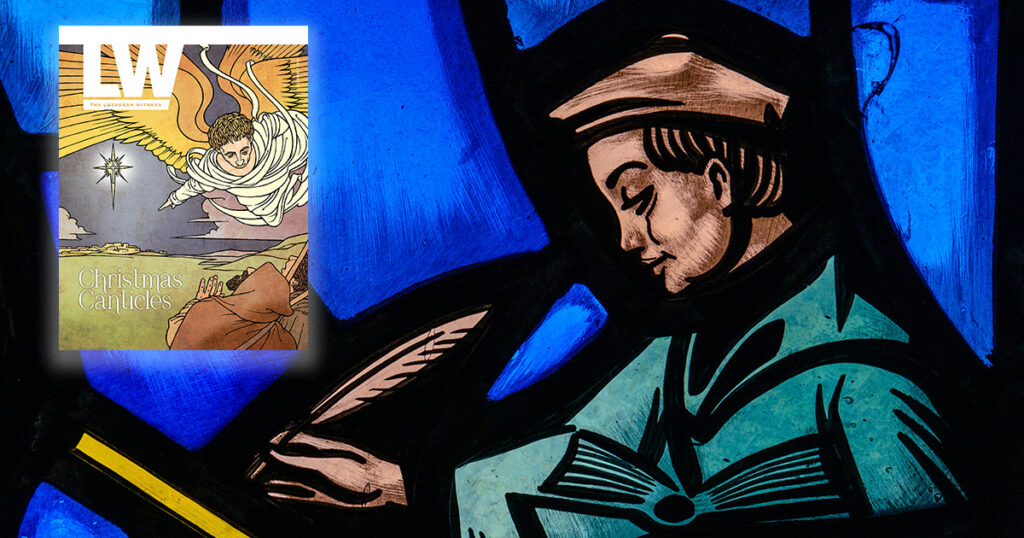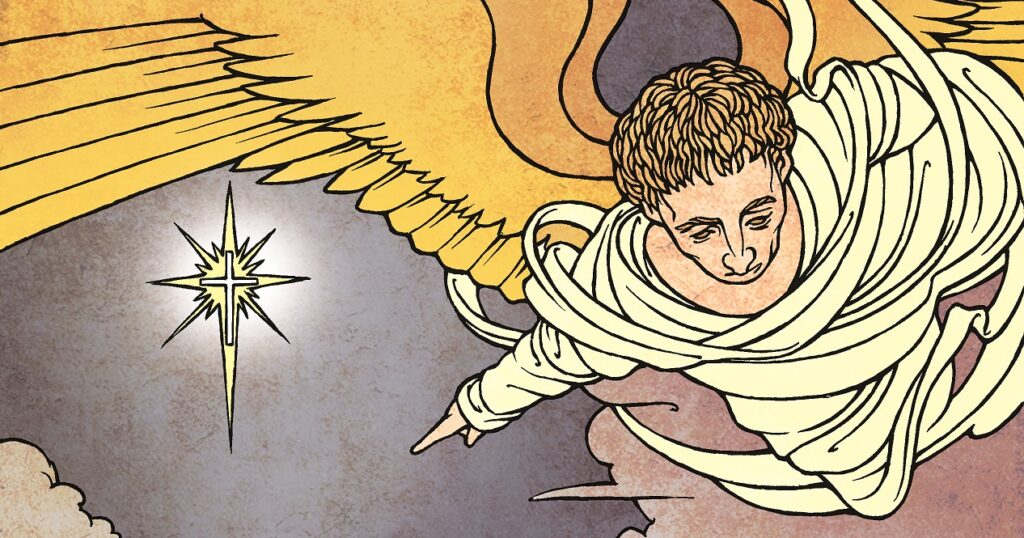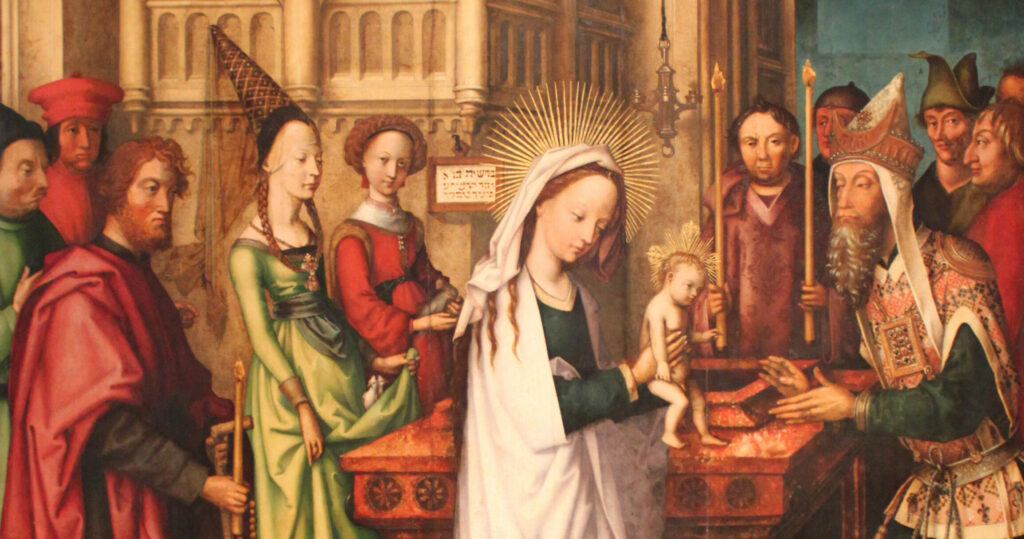In this series, Benjamin Kolodziej will reflect on several figures in American Lutheran sacred music history. This series is based on his new book Portraits in American Lutheran Sacred Music, 1847–1947 (Concordia Publishing House), which will be released in August and is available for pre-order now.

Descending from an ennobled lineage of five centuries, Martin Lochner claimed pastors, musicians, artists and teachers in his ancestral legacy. His father, Friedrich Lochner (1822–1902), the illustrious Lutheran theologian and liturgist of the 19th century, had come to America in 1844 as one of Wilhelm Loehe’s Sendlings, conveying his fondness for sacred music and liturgical scholarship to his son. Martin’s mother, Maria von Haugwitz, had descended from an ancient aristocratic family with branches in Silesia, Bohemia and Moravia, a family tracing its heritage back to Luther’s wife, Katherina von Bora.[1] The Lochners were thus steeped in the evangelical character of Lutheranism, a faith which invigorated the vocations of the manifold members who would themselves contribute to promoting the faith. It was into this auspicious pedigree that Martin Gustav Carl Lochner was born on Feb. 7, 1883, in Springfield, Ill.
A Youth Steeped in Sacred Music
Lochner attended Lutheran schools in Milwaukee before graduating from Concordia College in 1902. From 1893 until 1901, he studied organ with Christian F. Diez, cantor at Trinity, Milwaukee. After further piano studies, he enrolled at Concordia Seminary in St. Louis and was ordained in 1905, his first call after graduation taking him to Immanuel Lutheran College in Greensboro, N.C., an African American mission. [2]
As a young professional at Immanuel Lutheran College, Lochner cultivated a regional reputation as an outstanding organist. Almost two years into his position as teacher, the college dedicated their main building with festivities, including a celebratory concert:
The college choirs of Immanuel College at Greensboro were frequently heard during the festive days in the first week of June. The anthems and choruses, English and German, were well rendered, some excellently. Much credit is due to the instructors, Professors Lochner and Wahlers, who have taken great pains in developing the voices of the singers. . . . Prof. Lochner is a master on the pipe organ.[3]
Another local reviewer commended Lochner’s 1911 annual concert as “ a big success.”[4] Thus, even at the dawn of his career, Lochner could elicit the best from his students, handily cultivating a reputation as a fine Lutheran teacher and musician.
Concordia, River Forest
In 1912, Lochner accepted the call to teach at the Addison Teachers Seminary. The seminary was in the throes of building a new campus in River Forest, and the move was imminent. Theodore Kohn, secretary of the Addison Board of Control, and his brother, W.C. Kohn, the incoming president, both wrote to Lochner:
It will therefore also be your task not only to train our future school teachers to be capable and dextrous organists, but also to guide them into the paths of the noble, dignified, ancient Lutheran church music, so that future organists of our church can carry out their office to the glory of the Most High.[5]
The Kohns separately wrote to the Immanuel authorities beseeching them to release Lochner from his call, noting that “The professorship in Addison, to which Prof. M. Lochner has been appointed, is one of the most important in our teacher training seminary. … We believe that he can best use his musical gifts to the benefit of the Synod in a great and important way as part of the Teachers Seminary in Addison.”[6] This letter underscores both Lochner’s standing as a Missouri Synod musician even so early in his career, and the importance of the Addison seminary to the training of Lutheran sacred musicians.
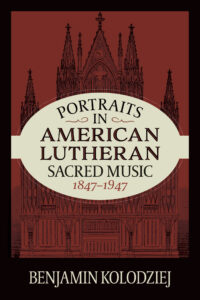
Lochner arrived in Addison that autumn,[7] before the institution moved to River Forest, where it was renamed Concordia Teachers College in 1914. From this institution, Lochner would enjoy a career encompassing performing, teaching and writing, the possibilities for which were enhanced by his suburban proximity to Chicago. Lochner’s primary teaching responsibilities included piano, organ, hymnology, music history, liturgy and worship. During the mid-1930s, the Concordia administration pressed for accreditation, necessitating that many faculty further their education, which task “they willingly accepted … enrolling in colleges and universities to work for advanced degrees.”[8] En route to a graduate degree in music at the University of Chicago, Lochner researched the origin of the hymn tune names in the Evangelical Lutheran Hymn-Book, a hymnal published by Concordia Publishing House in 1912 and representing the Synodical Conference’s first major foray into an English-language hymnal. In his thesis, Lochner traced the historical development and explored the rationale for the often arbitrary assignment of tune names.”[9] Although The Lutheran Hymnal was still several years in the future, Lochner had the new hymnal in mind when he labored to identify all these hymn tune names, certainly hoping that much of his work would apply to the new hymnal.[10] This also evidences his interest in hymnology — the relatively novel focus on hymnody as a historical and literary discipline as well as a spiritual one. Lochner graduated with his masters’ degree in music from Northwestern in 1938, having been elected to the Pi Kappa Lambda music fraternity.[11]
As a liturgical organist, Lochner represented a “middle way” between the more conservative, objective, 19th-century approach to playing and the more modern attitude which entrusts the organist with liberty for personal expression — although Lochner’s own style favored traditional practices, as enumerated in his own textbook, The Organist’s Handbook: A Guide to Lutheran Service Playing on Small Pipe Organ, Reed Organ, or Piano (1937). The audience for this book was the “many organists in our Lutheran churches who have not had any instruction in service playing. ”[12] In the opening pages, Lochner established the important vocation and office of the church organist, who “assists the pastor in proclaiming the glory of God.”[13] Lochner’s textbook sought to teach hymn and liturgy playing, organ registration, preludes and postludes, covering all manner of skills an organist would need to muster. That Lochner wrote the book in English represents the church’s reluctant transition from German into English, a practice finally enshrined only in the historical realities of World War II.
As a scholar, Lochner wrote prolifically for Das Schulblatt, which in 1920 was reinvented as Lutheran School Journal, Lochner channeling his energy into this paper, contributing editorials, reviews, and other ephemera. Nearly every teacher in the Missouri Synod received this periodical, for which Lochner was appointed music editor, wielding considerable influence to parish musicians in his reviews of CPH publications and advocacy for thoughtful sacred music practices, whether choral, organ, or hymnic.
Lochner’s Legacy
On the 25th anniversary of Lochner’s ordination, his brother, Rev. Wilhelm Lochner, feted Martin, noting that:
It is, therefore, the duty of an instructor of church music at our teachers’ seminaries to drill, above all things, the correct playing of a choral. In addition to this, however, he should train his students how to select the proper tunes, the proper preludes, the proper postludes, and to play them correctly.[14]
He thus reiterated the importance of sacred music to the life of the church of that era, and that the vocation of an organist, or of a cantor in the fullest sense of the term, necessarily involved specialized, professional training.
Martin Lochner died on February 6, 1945, on the way to play organ for a pastoral conference at First St. Paul’s, Chicago, fellow Concordia professor Albert Beck reminiscing of his colleague in March, 1945:
It is impossible to estimate how deep an influence his ideals and his teaching have had on the many hundreds of organists who were his pupils and who are serving congregations throughout Synod, but it can be said that the Lutheran Church has derived many benefits from his teaching at River Forest for more than thirty years.[15]
If he was no innovator, his frenzied work schedule precluding much significant musical composition of his own, Martin Lochner continued his family’s legacy of stewarding the rich musical heritage of the Lutheran church as he taught generations of church musicians to navigate the rigors of their vocations, his work directly portending the central role in church music studies that Concordia, River Forest, would assume during the latter half of the 20th century.
[1] H. D. Bruening, “Professor Martin Lochner, M. Mus.,” Concordia Historical Institute Quarterly 18, no. 3 (October, 1954): 67.
[2] “Installation of Prof. Martin Lochner at Greensboro, N. C.” The Lutheran Pioneer 27, no. 11 (November, 1905): 87.
[3] “North Carolina Items,” The Lutheran Pioneer 29, no. 7 (July, 1907): 55.
[4] “Final Exercises of Commencement at this Institution,” The Daily Record, June 3, 1911, 6.
[5] Typed letter from W. C. Kohn and Theodore Kohn to Martin Lochner, September 12, 1912. In the CHI archives, Louis Lochner 1887-1975 & Family Collection, 1524-1975, Folder 68 to 84, Box 6.
[6] Typed letter from W. C. Kohn and Theodore Kohn to Immanuel College, Greensboro, NC, September 12, 1912. In the Concordia Historical Institute archives, Louis Lochner 1887-1975 & Family Collection, 1524-1975, Folder 68 to 84, Box 6.
[7] August Stellhorn, Schools of the Lutheran Church, Missouri Synod (St. Louis: Concordia, 1963), 336.
[8] Alfred Freitag, College with a Cause: a History of Concordia Teachers College (Concordia, 1964), 138.
[9] Martin Lochner, The Organist’s Handbook: A Guide to Lutheran Service Playing on Small Pipe Organ, Reed Organ, or Piano, revised edition.(Concordia, 1947), 2. Originally published in 1937, the edition referenced will be the 1947 volume, published posthumously but adapted by Lochner for The Lutheran Hymnal when it came out in 1941.
[10] Lochner, The Organist’s Handbook, 2.
[11] “Martin Lochner Dies Suddenly in Chicago: Leader in Lutheran Music,” The Diapason 36, no. 4 (1 March, 1945): 2.
[12] Lochner, The Organist’s Handbook, Preface.
[13] Lochner, The Organist’s Handbook, 6.
[14] Wilhelm Lochner, “Anniversary of Prof. Martin Lochner, Oct. 15, 1933.” Typed manuscript at the Concordia Historical Institute, Louis Lochner 1887-1975 & Family Collection, 1524-1975, Folder 1 to 19, Box 1.
[15] Bruening, “Professor Martin Lochner, M. Mus.,” 70.


